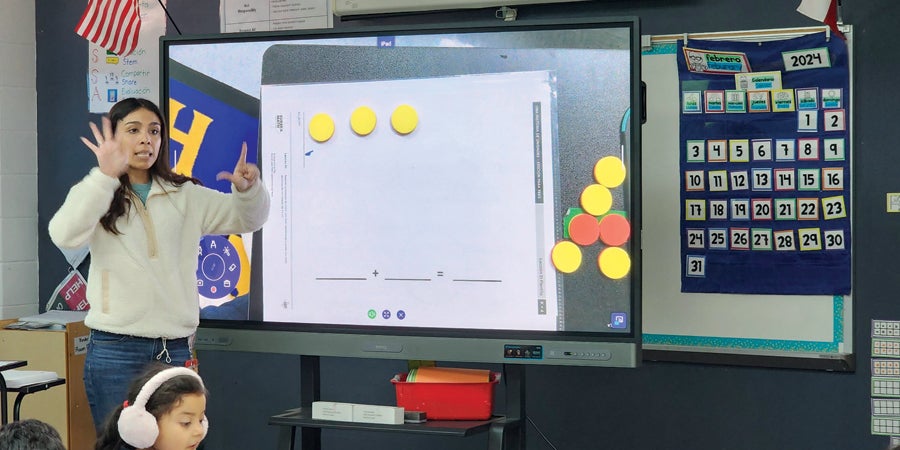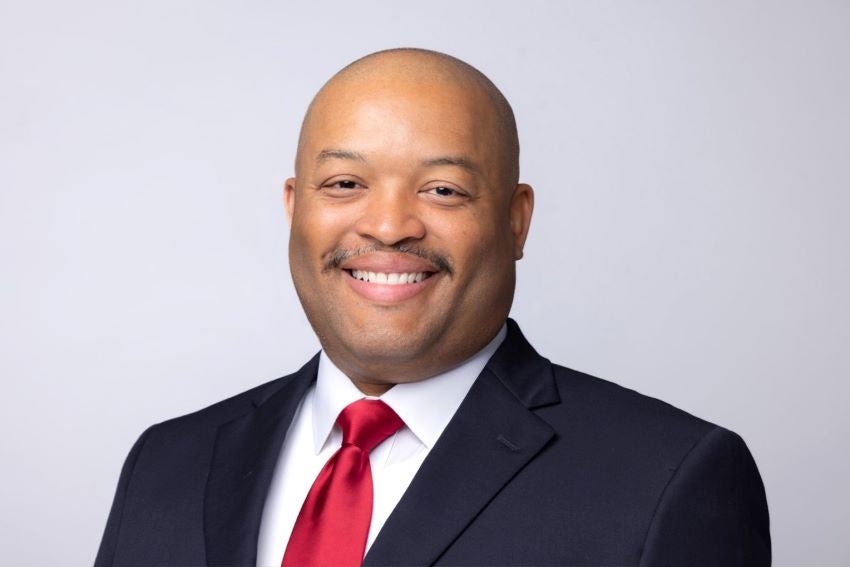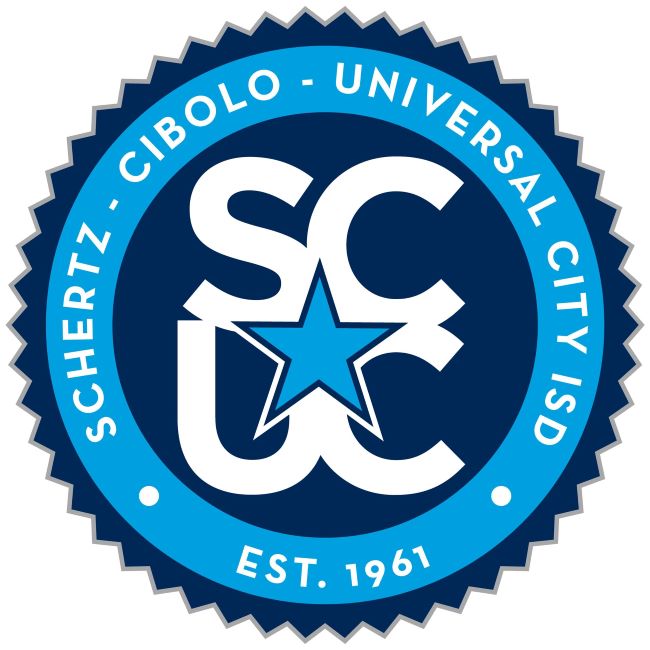Districts Seek Options to Fill Certified Bilingual Jobs

Edgewood ISD teacher Yamilet Olivares works with students at Roosevelt Dual Language Academy. Photo courtesy of Edgewood ISD.
When Victoria ISD was working on its strategic plan around 2019-20, the community’s residents made it clear they wanted all students to have exceptional teachers in the classroom, and that included certified bilingual teachers for the district’s growing number of bilingual emergent students.
“We don’t want to sell any of our students short in any way, shape, or form,” said Mike Mercer, Victoria ISD’s school board president. “And we have found that of all the positions we have to fill, that is one of the most difficult ones.”
Districts across the state are vying for certified bilingual teachers from the same limited pool of educators, making it a challenge for districts to be 100% staffed. And bilingual education is one of the few teaching areas where certification is federally required, along with special education and prekindergarten education. District leaders knew meeting the goal would be difficult, but they were ready to do what was needed to fill the positions, Mercer said.
“That’s been our charge as the board: to work within the strategic plan, setting the goals and the outcomes that we want to see within our district. And so one of the biggest goals is that we believe every child can learn and every child can succeed,” Mercer said. “That is a mantra that we carry from the boardroom down to the janitor’s closet and everywhere in between.”
Finding a solution began with the board giving the district’s administration and curriculum teams the autonomy to explore creative options to fill its bilingual teaching positions, he said.
Mercer explained that the Victoria ISD board had high expectations but trusted the administration who were the experts, and they were ready to give them the support they needed to achieve the district’s goals.
Victoria is known by locals as the “oasis in the desert,” said Mercer, who is an outgoing board member. Surrounded by rural areas, Victoria has the benefits of a big city without being too large. The district, located in southeastern Texas near the coast, serves nearly 13,000 students, a large number of which are bilingual education students.
“Bilingual education teachers play a crucial role in the language, academic, cultural, and cognitive development of students in our system who speak languages other than English,” said Victoria ISD Superintendent Sheila Collazo. “The new Victoria ISD strategic plan emphasizes the importance of highly empowered staff with knowledge, skills, and disposition to effectively ensure that students achieve academic success and make expected progress. Bilingual education teachers provide the tools, resources, and support for students to succeed in an increasingly multicultural and multilingual world.”
Filling a Need
According to the Texas Education Agency, the state of Texas serves nearly 1.2 million emergent bilingual students, and it says those numbers are steadily increasing.
While Victoria ISD was working on making changes aligned with its strategic plan, it was transitioning to a two-way dual language program, in which students who are emergent bilingual are integrated with those who already read and speak English. Mercer said the program allows the district to serve bilingual students and students wanting to learn a second language.
Roberto Rosas, Victoria ISD’s director for multilingual education, was charged with developing the program and finding certified teachers.
“That was one of the biggest challenges that we had at our district,” he said. “As a result, we reached out to Region 13 [ESC] and started bringing in some teachers from Spain.”
Victoria ISD is one of 19 districts from across the state taking part in the Texas-Spain Visiting International Teacher (VIT) Program.
The VIT Program is a collaboration between The Spanish Ministry of Education, Region 13 ESC, and The U.S. Department of State. Region 13 ESC serves as the program sponsor on behalf of the Department of State. The cultural exchange program’s goal is “promoting inter-culturalism between the United States and Spain, thereby encouraging citizens from both countries to foster an appreciation of the cultures shared by each community.”
District Support
Since 2011, TEA has charged Region 13 with administering the VIT program in Texas, said Jessica Pruneda, Region 13 ESC project coordinator for the Texas-Spain VIT Program. Interested districts apply during the fall application cycle with applications due in December, she said.
“Districts are really encouraged to create a detailed plan of support for the visiting teachers, to assign a liaison that supports them throughout the duration of the program, to establish communication as soon as the teachers are selected, and to really, really begin interdepartmental planning, identifying each department’s role in the support it will provide teachers, and including all of that information in their plan of support,” Pruneda said.
Along with new applicants who must apply for consideration, participating districts must reapply every year for the program, she said. There were 17 districts in the program in 2023-24, but two new districts were accepted for the 2024-25 school year: Midland ISD and Harlingen CISD.
Pruneda and Erin Romero, Region 13’s director of special projects, administer and support the program, while collaborating with a Spanish education advisor housed at Region 13 who supports the teachers and districts.
“The daily technical assistance is a very important aspect of the framework of support that we have established in the VIT program at Region 13,” Pruneda said.
Region 13 doesn’t control the number of candidates available each year; that falls to The Spanish Ministry of Education, Pruneda said. Region 13 typically limits the number of teachers sent to a newly participating district.
“We try to be cautious and understand that the district is going to be in its first year of the program, and it is going to be going through a learning curve,” Pruneda said. “That first year is a huge learning year for the district and for us as we guide the district as they host the teachers.”
Seeking Solutions
At Victoria ISD, the district brought in three teachers from Spain in the first year and had a great experience working with them, Rosas said. “So, we continued with that program to be able to get some of those certified teachers that we were needing. However, it wasn’t enough.”
Right now, there is a pool of about 100 teachers available to districts per year, Pruneda said. There are close to 300 active teachers across the state in different districts. The teachers can work in the U.S. for three years and can choose to extend their J-1 visas for up to two years.
Still needing more certified bilingual teachers, Rosas came up with the idea to partner with a university in Mexico. Rosas approached several universities before finding a partner in Escuela Normal Superior de Jalisco. Just recently, the district signed on a second partner university that it will begin working with in the 2025-26 school year.
To prepare the university’s education students for success in the district, Victoria ISD provided the university with materials it wanted incorporated into its education classes, focusing on instruction, English fluency, and the financial and cultural challenges of living abroad, he said.
The university was charged with finding qualified teachers who were interested in the program. The students first went through the training program. Then, the university vetted the teachers, selecting the best candidates, who would then be interviewed for the open positions, Rosas said.
Getting the program off the ground took lots of planning, trust building, and communication, he said. But much of the organization and planning were handled remotely.
In the first year, the district hired one teacher from Mexico, Rosas said. The university wanted to test the program out, sending one of its alums who taught fifth grade.
“He was instrumental in helping to refine the program,” Rosas said. “He was able to share his experiences with the program. That led the way to hire four more teachers.”
The district has 14 bilingual education teachers with five from Mexico and the remaining teachers from Spain. The teachers on the J-1 visa must have two years’ experience teaching, but some have far more, Rosas said.
“The overall statewide teacher shortage persists, underscoring the need for continued investment in teacher preparation programs, competitive compensation, and supportive work environments to ensure that all students, especially emergent bilinguals, receive the quality education they deserve,” Collazo said. “It is our ethical and professional responsibility to create the culture and conditions for these students to thrive.”
District Collaboration
In June 2024, Victoria ISD held a session at TASB's Summer Leadership Institute, sharing the benefits of the programs in the district. Sara Burleson, a Midland ISD board member, was in the audience and ready to learn more.
Midland ISD’s school board had just voted to use J-1 visas to bring teachers into the district, she said.
“There were some board members with concerns about that and then others who were not [concerned],” Burleson said. “I was interested in how they [Victoria ISD] navigated the J-1 visas.”
Victoria ISD’s proactive stance made sense to Burleson, a former teacher, who said, “Across the state of Texas, we all have the same problem: we all need bilingual teachers and they’re in very short supply.”
Midland ISD began working with the VIT program, along with hiring teachers with an H-1B visa, which is for specialty fields that are hard to fill within the U.S.
Filling positions for the district of 29,500 students — 20% of whom are emergent bilingual — is also more challenging because of its remote location in West Texas, Burleson said.
“We need more teachers that are bilingual,” she said, adding, “But we also have 52 languages.”
Creating a Pipeline
Edgewood ISD in San Antonio is using a grow-your-own program along with a paid residency program to fill the need for certified bilingual teachers, said Thomasina Montaña, the district’s director of professional learning and recruiting and hiring.
The district partnered with The University of Texas at San Antonio’s College of Education and Human Development to recruit student teachers for its residency program, Montaña said. The program was initially paid for with Texas COVID Learning Acceleration Supports grant funding.
The residency program allows students who are seniors in college to teach for the full year as part of their clinical, she said. The students are paid $20,000.
The first year Edgewood was trying to fill 13 bilingual education spots, competing with six other districts. In the end, eight of the 13 students chose to work in Edgewood, and five of the original residents are still with the district today, now employed as full-time teachers.
Those former residents have become an integral part of the recruiting process for new residents, she said. But changes to the residency program by the university put limits on the number of students they could recruit.
So, the district started its own grow-your-own program, tapping into the talent already on staff: its paraprofessionals, she said. The paraprofessionals are familiar with the district, its culture, and its students. The district sought out paraprofessionals who had 60 credit hours or more and were pursuing a bachelor’s degree in bilingual education.
The new hires took on the role of classroom instructors while also taking online courses through a partner university, Montaña said. It takes them two years to complete the program. While they work toward their degree, the teachers are paid their classroom instructor salary, their tuition is paid, and the mentors who support them receive a stipend.
“They know the community and so they are committed to the district,” Montaña said. “They know this is an opportunity for them, so they are willing to say, ‘You know what, Edgewood is going to support me. I’m going to stay with them.’”
Midland ISD is also exploring a grow-your-own option. The district is offering its high school students the chance to sign a letter of intent stating that upon completion of their bachelor’s degree in education, the district will hire them, Burleson said. The district even held its first signing day last year with nearly 20 students signing a letter of intent.
“The bottom line is we’ve got to get more students back wanting to be teachers again,” Burleson said. “And make it a profession that is respected again and that pays for the work they’re doing.”
Mary Ann Lopez is a staff writer for Texas Lone Star.
Mary Ann Lopez
Mary Ann Lopez is a senior communications specialist for TASB.




